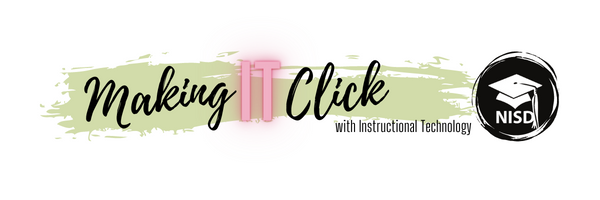How does a teacher deliver a visual presentation with a broken projector? How can a presentation be viewable to ALL students in the room, no matter how close or far from the screen they are? How can a teacher with any size class gather immediate feedback from every student during a lesson, whether it is a planned question or an on-the-spot question? The answer is Nearpod!
 |
| A class of 60+ accessing a Nearpod presentation simultaneously. |
Physics teacher at Byron Nelson, Courtney Toht, temporarily delivers content to two full classes at a time as she supports students for a team teacher who is out on maternity leave. Her Science classroom had the physical space for 60+ students at a time, but students at the back of the room could not view the projected presentation at the front of the room and it was difficult to gauge students' understanding for such a vast number of kids...until she started using Nearpod.
Nearpod enables the teacher to take existing presentations from PowerPoint or Google Slides and import it into Nearpod. Once in Nearpod, the teacher can embed questions in the following formats: open-ended, poll, or quiz. These can be added prior to the presentation starting as well as can be added in during the presentation as need arises.
To join a live-presentation, Nearpod generates a 5 character code that can be written on the whiteboard, shared as a clickable URL, or assigned to a class in Google Classroom. Once a student connects into a Nearpod presentation, the presentation appears on each individual student's computer; so, previously-projected content can be accessible anywhere. Better yet, there is an iPad app for Nearpod so the teacher can control the progress of the presentation while being mobile around the room. When the teacher progresses to the next slide in a live-presentation that is teacher-paced, so does the presentation on the individual student computers.
After content slides are delivered, an open-ended formative question uses accompanies the content to gauge student understanding. When a formative question appears in the presentation, a new screen appears on the student computers with the question that has been posed to the class and a space to answer the question.
Nearpod enables the teacher to take existing presentations from PowerPoint or Google Slides and import it into Nearpod. Once in Nearpod, the teacher can embed questions in the following formats: open-ended, poll, or quiz. These can be added prior to the presentation starting as well as can be added in during the presentation as need arises.
To join a live-presentation, Nearpod generates a 5 character code that can be written on the whiteboard, shared as a clickable URL, or assigned to a class in Google Classroom. Once a student connects into a Nearpod presentation, the presentation appears on each individual student's computer; so, previously-projected content can be accessible anywhere. Better yet, there is an iPad app for Nearpod so the teacher can control the progress of the presentation while being mobile around the room. When the teacher progresses to the next slide in a live-presentation that is teacher-paced, so does the presentation on the individual student computers.
After content slides are delivered, an open-ended formative question uses accompanies the content to gauge student understanding. When a formative question appears in the presentation, a new screen appears on the student computers with the question that has been posed to the class and a space to answer the question.
 |
| Student View: Displayed Formative Question with Space to Answer |
As students answer, the teacher can view submitted responses to gather on-the-spot feedback that can be used to assess learning at any given moment. The teacher view also shows the percentage of students that have answered. A setting can be changed the make the students names appear anonymous so a teacher can show all submitted answers without associating a name to the response.
 |
| Teacher View: Formative Question Feedback |
If an exemplar answer gets submitted, the teacher can choose to share a selected response which means that answer gets pushed through to be viewable on all student computers. Mrs. Toht uses this feature to gauge understanding of newly presented material and shares students' answers to help them interpret the information using student-friendly and student-generated responses. Note that once the teacher shares a response, the activity closes and students can no longer continue submitting responses.
All features shown in this post are included in the free version with the exception of having 60 students connected at once; the free version allows up to 30 students to connect at a time. Upgraded features include the ability to assign student-paced lessons as well as additional question styles such as a "Draw It" style question which allow students to use their touchscreen or mouse to draw a picture or solve an equation by showing their work as pictured below. Same as the open ended questions, the teacher can view all students submitted work and share a selected response.
1C - Promote student reflection using collaborative tools to reveal and clarify students' conceptual understanding and thinking, planning, and creative processes.
2D - Provide students with multiple and varied formative and summative assessments aligned with content and technology standards, and use resulting data to inform learning and teaching.



No comments:
Post a Comment
Note: Only a member of this blog may post a comment.